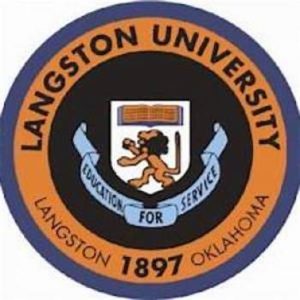
Langston's Logo
*On this date, we celebrate the founding of Langston University, Oklahoma’s only Historical Black College or University (HBCU).
The university was founded as a land grant college through the Morrill Act of 1890 and officially established by House Bill 151 on March 12, 1897, as the Colored Agricultural and Normal University. Over one hundred years old, Langston University moves with confidence toward the second century of excellence. On November 16, 1907 (the year Oklahoma became a state), Langston City was officially established. Since Blacks were not permitted to attend any higher education institutions in Oklahoma Territory, Black citizens appeared before the Oklahoma Industrial School and College Commission in July 1892 to petition Langston to have a college.
The purpose of the university was to instruct "both male and female Colored persons in the art of teaching various branches which pertain to a common school education and in such higher education as may be deemed advisable, and in the fundamental laws of the United States in the rights and duties of citizens in the agricultural, mechanical and industrial arts." One stipulation was that the land on which the college would be built would have to be purchased by the citizens.
Picnics, auctions, and bake sales were held to raise money, and Black settlers determined to provide higher education for their children purchased the land within a year. On September 3, 1898, the school was opened in a Presbyterian Church in Langston with an initial budget of $5,000. The first president was Dr. Inman E. Page, the son of a former slave who had purchased freedom for himself and his family. During the Page administration, the campus expanded to 160 acres. Enrollment increased from 41 to 650, faculty from 4 to 35, classroom buildings and dormitories were constructed, and the curriculum was strengthened. Langston eventually received 100,000 acres, primarily in western Oklahoma, with some in Logan County and a small number in New Mexico.
Funds derived from the rental and leasing of these lands have greatly benefited the school, as have one-tenth of the New Morrill Act funds. In the 1990s, numerous improvements and initiatives were completed. The residence of former presidents (the White House), renovated and dedicated to the Helen Aline Johnson Hospitality Management Center, includes housing for campus guests and a restaurant. The renovation was completed on the G. Lamar Harrison Library, which now features a bell tower that is the architectural focus of the campus.
The William H. Hale Student Union dining facilities were expanded for $400,000. Also, the Randy Ponder Military Center has been established in the Student Union to provide opportunities for students to join the National Guard on campus, the first such establishment of an agreement between a college and the National Guard in the nation. Cable TV was installed on campus, and the university participates in instructional TV through the Higher Education Telecommunications Network (HETA) and the Black College Telecommunications Network (BCTN). The Professional Counseling Center, the Small Business Development Center, and the National Institute for the Study of Minority Enterprise program were also established.
The Federal Aviation Administration (FAA) has officially adopted Langston University to support the Department of Technology. It is establishing a B.S. degree program in Airway Science, a cooperative effort with Oklahoma State University. Another cooperative project with the Soil Conservation Service provides a liaison to assist with programs and activities in the Agriculture Department. The Oklahoma City Urban Center has been expanded to offer classes at Tinker Air Force Base.
The graduate program now offers courses at the Oklahoma City and Tulsa Urban Centers leading to the Master of Education degree. The history-making activities continue a proud tradition of transforming challenges into accomplishments, demonstrating academic excellence as Langston University excels in the 21st Century.
Black American Colleges and Universities:
Profiles of Two-Year, Four-Year, & Professional Schools
by Levin Hill, Pub., Gale Group, 1994
ISBN: 0-02-864984-2